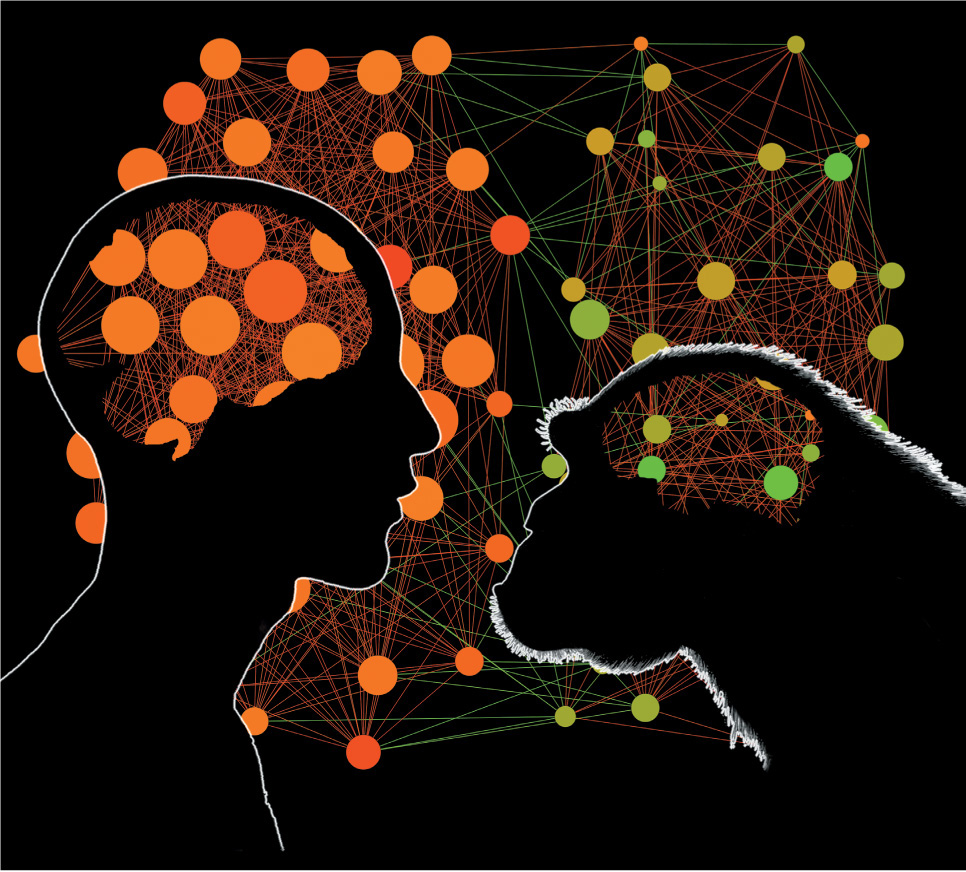Genetic Differences That Make Us Human

Over 140 years ago, Charles Darwin proposed that humans shared a recent common ancestor with the African great apes. Today there is significant evidence that our closest living relative is the chimpanzee. Fossil evidence indicates that humans and chimpanzees diverged genetically only 5 to 7 million years ago—a mere blink of the eye in evolutionary time. Yet humans and chimps differ in a large number of anatomical, physiological, behavioral, and cognitive traits. For example, there are numerous differences in the structure of the backbone, pelvis, skull, jaw, teeth, hands, and feet of humans and chimpanzees. The size of the human brain is more than twice that of the chimpanzee; and humans exhibit complex language and cultural characteristics not seen in chimpanzees. Indeed, the degree of phenotypic difference between chimpanzees and humans is so large that scientists place them into entirely different primate families (humans in the family Hominidae and chimpanzees in the family Pongidae).
In spite of the large phenotypic gulf between humans and chimpanzees, sequencing of their genomes reveals that their DNA is remarkably similar. Only about 1% of individual base pairs differ between the two species, along with a 3% difference in insertions and deletions. Thus, 96% of the DNA of humans and chimpanzees is identical. But clearly humans are not chimpanzees. How then, did humans and chimpanzees come to be so different? Where are the genes that make us human?
A possible answer to this paradox was proposed by geneticists Mary-Claire King and A. C. Wilson in 1975. Using the limited techniques available at the time (comparison of amino acid in proteins and DNA hybridization studies), King and Wilson concluded that humans and chimpanzees differed at only about 1% of their DNA sequences. To explain how these very small genetic changes could account for the extensive physical and behavioral differences between humans and chimpanzees, King and Wilson suggested that the genetic variations that make us human are concentrated in regulatory sequences—those parts of the genome that control the expression of other genes. In this way, small genetic changes might influence the expression of numerous other genes and affect the phenotypes of many traits simultaneously. Unfortunately, there were no techniques available at the time to examine regulatory sequences and to test their hypothesis.
Fast-forward to 2009. Using cutting-edge techniques of genomic research and bioinformatics, Katja Nowick and her colleagues at the University of Illinois and the Norwegian University of Science and Technology identified a group of 90 transcription factors whose expression differed significantly between humans and chimpanzees. As discussed in Chapter 13, transcription factors are proteins that bind to DNA and facilitate or repress the synthesis of RNA, the first step in the process of information transfer from genotype to phenotype. Each transcription factor may affect the expression of multiple genes, so a small genetic change affecting the expression of a single transcription factor can influence many additional genes. The differences that Nowick and her colleagues found in the expression of transcription factors were particularly pronounced in brain tissue, where they may account for the large differences in neural and cognitive function of humans and chimpanzees.
Many of the transcription factors that Nowick and colleagues identified were Krüppel-associated box domain zinc finger proteins (KRAB-ZFPs), transcription factors that bind to specific DNA sequences and bring about changes in chromatin structure. As we will discuss in this chapter, changes in chromatin structure are often involved in regulation of gene expression. Other studies have demonstrated that KRAB-ZFPs have evolved rapidly in humans, probably because they were favored by natural selection. The transcription factors identified by Nowick and colleagues clustered into two distinct but interconnected regulatory networks, which control energy metabolism, transcription, vesicular transport, and protein modification.
These results support the idea first proposed by King and Wilson: that changes in a relatively small number of regulatory sequences affect expression of numerous genes in humans and chimpanzees and help produce the large differences we see in anatomy, brain size, cognition, and behavior.
This chapter is about gene regulation in eukaryotic cells, the very changes that help to make humans unique. Gene regulation typically takes place at multiple levels. We begin by considering how gene expression is influenced by changes in chromatin structure, which can be altered by several different mechanisms. We next consider the initiation of transcription in eukaryotes, which is controlled by a complex interaction of several types of proteins and the DNA regulatory elements to which they bind. We examine several ways in which gene expression is controlled through the processing, degradation, and translation of mRNA. We end by revisiting some of the similarities and differences in gene regulation in bacteria and eukaryotes.